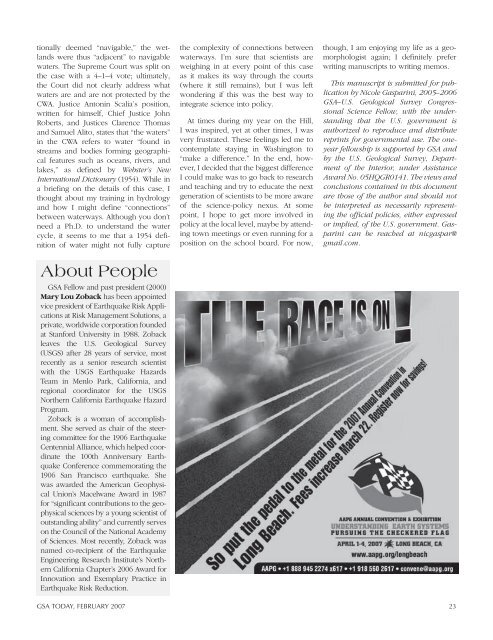A Scientific Sabbatical on Capitol Hill - Geological Society of America
A Scientific Sabbatical on Capitol Hill - Geological Society of America
A Scientific Sabbatical on Capitol Hill - Geological Society of America
Create successful ePaper yourself
Turn your PDF publications into a flip-book with our unique Google optimized e-Paper software.
ti<strong>on</strong>ally deemed “navigable,” the wetlands<br />
were thus “adjacent” to navigable<br />
waters. The Supreme Court was split <strong>on</strong><br />
the case with a 4–1–4 vote; ultimately,<br />
the Court did not clearly address what<br />
waters are and are not protected by the<br />
CWA. Justice Ant<strong>on</strong>in Scalia’s positi<strong>on</strong>,<br />
written for himself, Chief Justice John<br />
Roberts, and Justices Clarence Thomas<br />
and Samuel Alito, states that “the waters”<br />
in the CWA refers to water “found in<br />
streams and bodies forming geographical<br />
features such as oceans, rivers, and<br />
lakes,” as defined by Webster’s New<br />
Internati<strong>on</strong>al Dicti<strong>on</strong>ary (1954). While in<br />
a briefing <strong>on</strong> the details <strong>of</strong> this case, I<br />
thought about my training in hydrology<br />
and how I might define “c<strong>on</strong>necti<strong>on</strong>s”<br />
between waterways. Although you d<strong>on</strong>’t<br />
need a Ph.D. to understand the water<br />
cycle, it seems to me that a 1954 definiti<strong>on</strong><br />
<strong>of</strong> water might not fully capture<br />
the complexity <strong>of</strong> c<strong>on</strong>necti<strong>on</strong>s between<br />
waterways. I’m sure that scientists are<br />
weighing in at every point <strong>of</strong> this case<br />
as it makes its way through the courts<br />
(where it still remains), but I was left<br />
w<strong>on</strong>dering if this was the best way to<br />
integrate science into policy.<br />
At times during my year <strong>on</strong> the <strong>Hill</strong>,<br />
I was inspired, yet at other times, I was<br />
very frustrated. These feelings led me to<br />
c<strong>on</strong>template staying in Washingt<strong>on</strong> to<br />
“make a difference.” In the end, however,<br />
I decided that the biggest difference<br />
I could make was to go back to research<br />
and teaching and try to educate the next<br />
generati<strong>on</strong> <strong>of</strong> scientists to be more aware<br />
<strong>of</strong> the science-policy nexus. At some<br />
point, I hope to get more involved in<br />
policy at the local level, maybe by attending<br />
town meetings or even running for a<br />
positi<strong>on</strong> <strong>on</strong> the school board. For now,<br />
though, I am enjoying my life as a geomorphologist<br />
again; I definitely prefer<br />
writing manuscripts to writing memos.<br />
This manuscript is submitted for publicati<strong>on</strong><br />
by Nicole Gasparini, 2005–2006<br />
GSA–U.S. <strong>Geological</strong> Survey C<strong>on</strong>gressi<strong>on</strong>al<br />
Science Fellow, with the understanding<br />
that the U.S. government is<br />
authorized to reproduce and distribute<br />
reprints for governmental use. The <strong>on</strong>eyear<br />
fellowship is supported by GSA and<br />
by the U.S. <strong>Geological</strong> Survey, Department<br />
<strong>of</strong> the Interior, under Assistance<br />
Award No. 05HQGR0141. The views and<br />
c<strong>on</strong>clusi<strong>on</strong>s c<strong>on</strong>tained in this document<br />
are those <strong>of</strong> the author and should not<br />
be interpreted as necessarily representing<br />
the <strong>of</strong>ficial policies, either expressed<br />
or implied, <strong>of</strong> the U.S. government. Gasparini<br />
can be reached at nicgaspar@<br />
gmail.com.<br />
About People<br />
GSA Fellow and past president (2000)<br />
Mary Lou Zoback has been appointed<br />
vice president <strong>of</strong> Earthquake Risk Applicati<strong>on</strong>s<br />
at Risk Management Soluti<strong>on</strong>s, a<br />
private, worldwide corporati<strong>on</strong> founded<br />
at Stanford University in 1988. Zoback<br />
leaves the U.S. <strong>Geological</strong> Survey<br />
(USGS) after 28 years <strong>of</strong> service, most<br />
recently as a senior research scientist<br />
with the USGS Earthquake Hazards<br />
Team in Menlo Park, California, and<br />
regi<strong>on</strong>al coordinator for the USGS<br />
Northern California Earthquake Hazard<br />
Program.<br />
Zoback is a woman <strong>of</strong> accomplishment.<br />
She served as chair <strong>of</strong> the steering<br />
committee for the 1906 Earthquake<br />
Centennial Alliance, which helped coordinate<br />
the 100th Anniversary Earthquake<br />
C<strong>on</strong>ference commemorating the<br />
1906 San Francisco earthquake. She<br />
was awarded the <strong>America</strong>n Geophysical<br />
Uni<strong>on</strong>’s Macelwane Award in 1987<br />
for “significant c<strong>on</strong>tributi<strong>on</strong>s to the geophysical<br />
sciences by a young scientist <strong>of</strong><br />
outstanding ability” and currently serves<br />
<strong>on</strong> the Council <strong>of</strong> the Nati<strong>on</strong>al Academy<br />
<strong>of</strong> Sciences. Most recently, Zoback was<br />
named co-recipient <strong>of</strong> the Earthquake<br />
Engineering Research Institute’s Northern<br />
California Chapter’s 2006 Award for<br />
Innovati<strong>on</strong> and Exemplary Practice in<br />
Earthquake Risk Reducti<strong>on</strong>.<br />
GSA TODAY, FEBRUARY 2007 23
















